Swing Break
 March 21st, 2011 by jules
March 21st, 2011 by jules
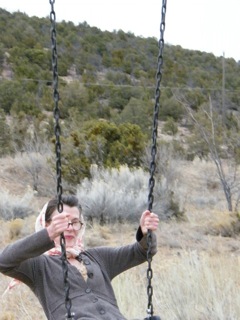 Quiet picture books. Contemplative. Books that capture a feeling, a moment in time, not picture books In Which Many Things Happen All At Once. They’re hard to do well. It’s challenging, I’m sure, to do gentle. But Tricia Tusa—who visited me for breakfast in 2008 and is back again this morning with some art work and sketches—not only does them well, she gives us a veritable case study in doing it well with her latest title, which she both wrote and illustrated, Follow Me, to be released next month by Houghton Mifflin Harcourt.
Quiet picture books. Contemplative. Books that capture a feeling, a moment in time, not picture books In Which Many Things Happen All At Once. They’re hard to do well. It’s challenging, I’m sure, to do gentle. But Tricia Tusa—who visited me for breakfast in 2008 and is back again this morning with some art work and sketches—not only does them well, she gives us a veritable case study in doing it well with her latest title, which she both wrote and illustrated, Follow Me, to be released next month by Houghton Mifflin Harcourt.
Now, as a child I loved to swing. In fact, I still do. (Nearly-forty, schmearly-forty.) Clearly, Ms. Tusa loves to swing, too. Pictured left, she is launching her own adventure. On the cover of this beautiful picture book, pictured below, we see a young girl mounting a swing, hanging from a tree. On the dedication page, pictured at the bottom of this post, we get a hint as to her eventual release from the swing, as we see it flipped up into the air with her no longer on it. Ooh: Intriguing! Then, the story begins: “I wander through pink and get lost in blue.” She’s swinging, yes, but hang on. Stick with the book. Because it’s about much more than merely swinging.
The girl takes actual flight and gets lost. I’d love to tell you all of Tusa’s lyrical, evocative text here, as the young girl loses herself in the air, but you’ll have to go find a copy for yourself, by hook or by crook, next month, since: 1) I don’t want to give away the entire experience of the book and 2) doing so would also kinda sorta make me a copyright jerk. Suffice it to say she drifts through colors that she loves, she follows the breeze, allowing herself to get “caught in its folds,” and she reaches up and she reaches out and she reaches across. Lost in, not only the colors, but her own music, her own particular euphony (in more ways than one). Don’t expect any crazy plot points here: She simply takes a flight of fancy, the type of imaginative romp a child dreams of when swinging. Er, okay. Grown-ups, too. Come on. As Tricia shows us above, you’re never too old to swing, dear readers.
I really love this book, and before I sat down to compose this post, I read the professional reviewers’ thoughts on the matter. They’re across-the-board positive, I discovered, and—in fact—now I just want to tell you what they said. Especially this from Publishers Weekly. I mean, this nails one of the many ways in which this book works:
It’s Tusa’s portrait of the ideal childhood, liberated from the tyranny of schedules and achievement. Action-oriented kids may wonder why nothing happens; inward-turned imaginers will recognize themselves.
YES! You know you’re nodding your head to the phrase “tyranny of schedules and achievement,” and that’s because it’s ever-so true that contemporary American childhood is rife with this. Rife, I say. Again, it’s one of many ways in which this book enchants, some of the others being Tusa’s palette, her strong lines, the space she leaves in many of the compositions, and her ability to transport us to this escapement, this brief moment in time in which we lose ourselves with our dreamy protagonist and which feels like a long, spacious interlude — and which, for the girl, probably lasted all of a few minutes, for all we know.
Kirkus adds: “All of what she sees—trees and sky, leaves and seeds, birds and flowers—are in her backyard, but she has transformed them with the power of her imagination as strongly as if she had sprinkled them with fairy dust. A glorious visual meditation on light, color and home for even the smallest child and artist.” That emphasis is mine, because I’m YES’ing again to that reviewer’s statement. I’m even doing a fist-pump and high-fiving my own self, merely out of enthusiasm for the book and a good reviewer who captured it so well.
Know what else I think captures a picture book well? The art. It can say so much more than I can. Fortunately, before she mounted that swing, Tricia sent some illustrations from it, as well as some thumbnails, early sketches, and—briefly—her thoughts on what she set out to communicate with this book. Without further ado, here’s Tricia . . .
“I really wanted this book to have a very imperfect, hand-done quality to it, similar to the books I loved as a child. And so I decided to use an etching process. I etched the linework into a plate, rubbing inks into the line. I then rolled the plate and paper through a press. I decided on a limited palette of color and applied it as a single layer, printing one color at a time — almost like a monoprint.
With this book, I wanted to try to convey, with as few of words as possible, the feeling of connection to self as a child — where all senses are fully engaged. An intensely satisfying relationship between you and yourself. One I discover daily … and still enjoy!
(Click to enlarge)
(Click to enlarge)
The thumbnail sketches help me to figure out the pacing of a book. They also allow me to see the book in its entirety, revealing how the book works as a whole. Thumbnails also make clear the amount of variety from page to page.
Sketches from the dummy are drawn fairly quickly in order for me to achieve the spontaneity that I want. Drawing quickly also allows for me to get out of my own way. I draw with my favorite pencil on tracing paper. I then xerox these, tape the dummy together, and send it to the editor. If you compare many of my sketches to the actual book art, you will see quite a few changes that I make along the way. The editor and/or art director will suggest some of these changes … or I will make them on my own.“
(Click to enlarge)
Many thanks to Tricia for visiting. What a fitting book to post about on the first day after the first day of Spring, and I didn’t even plan that. (I’m hardly organized here at 7-Imp Central.)
Now, if you’ll excuse me, there’s a swing calling my name…
FOLLOW ME. Copyright © 2011 by Tricia Tusa. Published by Harcourt Children’s Books, Boston. All rights reserved.
All other images used with permission of Tricia Tusa.

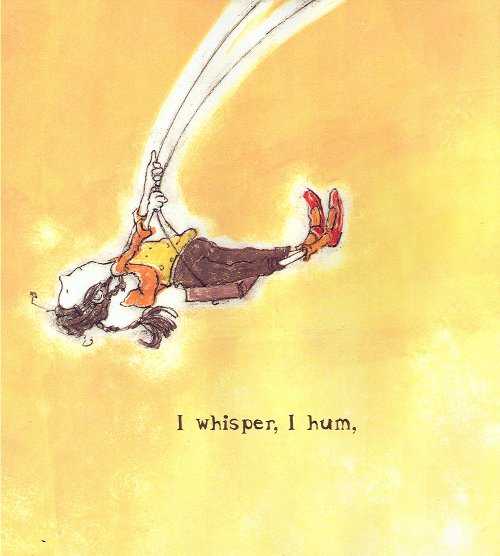
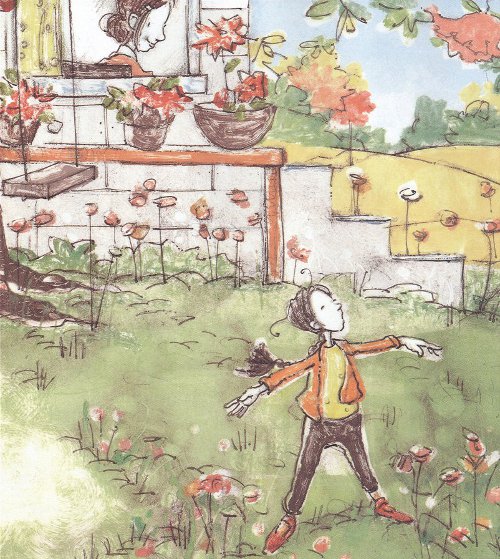
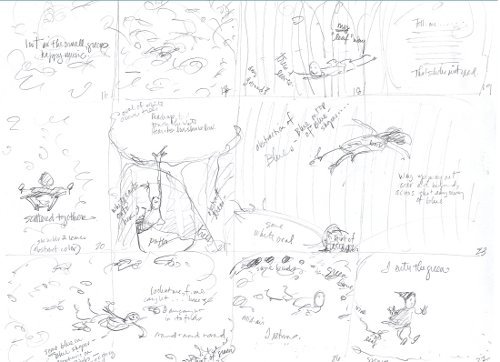

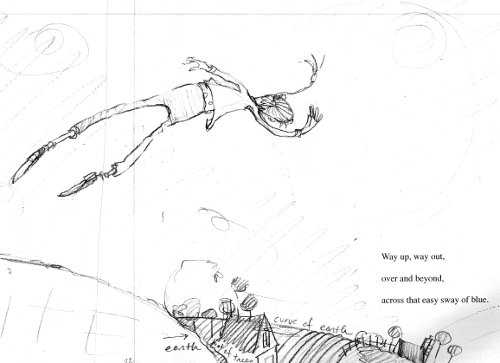

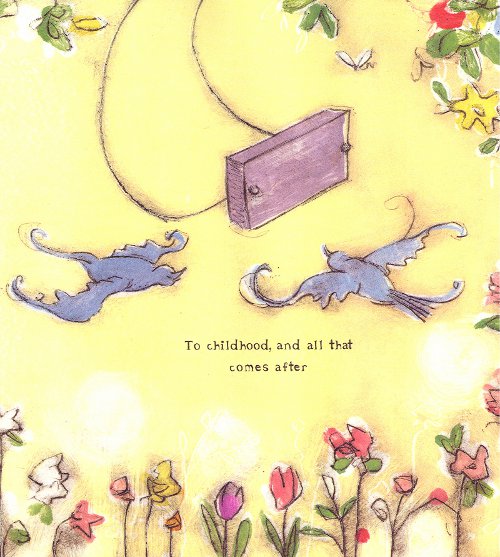

That pretty much sums it up (in a most succinct and eloquent way!). What a beautiful tribute to the essence of childhood, to imagination, and to following possibilities! I want to follow her for sure!
Oh, this book looks so lovely! The art really conveys a childlike reverie. This is definitely one to be quietly experienced, a welcome break from all the noisy “look at me” PBs that flood the shelves each season.
I wonder at the “tyranny of schedules and achievement.” Why has it come to this — for kids as well as adults?
Wow. I think I’m in love.
memories flood me – ‘going even with the bars’ even though knowing our underpants would show gave us a sense of wild abandon in the 40’s and 50’s! i still love to swing – thanks, jules, for sharing this
I have always loved Tricia Tusa, and even though I didn’t think it was possible, I love her even more now. I can’t wait to get my hands on this book. The mood, the illustrations, all of it is so inspiring. Thanks for this post. It made my day!
Gorgeous.
I wish all good picture books came with a copy of the illustrator’s dummy book! Maybe the publisher could slip a small version of it in the inside back cover (where there would be a pocket of sorts). I’d be so happy.
I love her sketches!